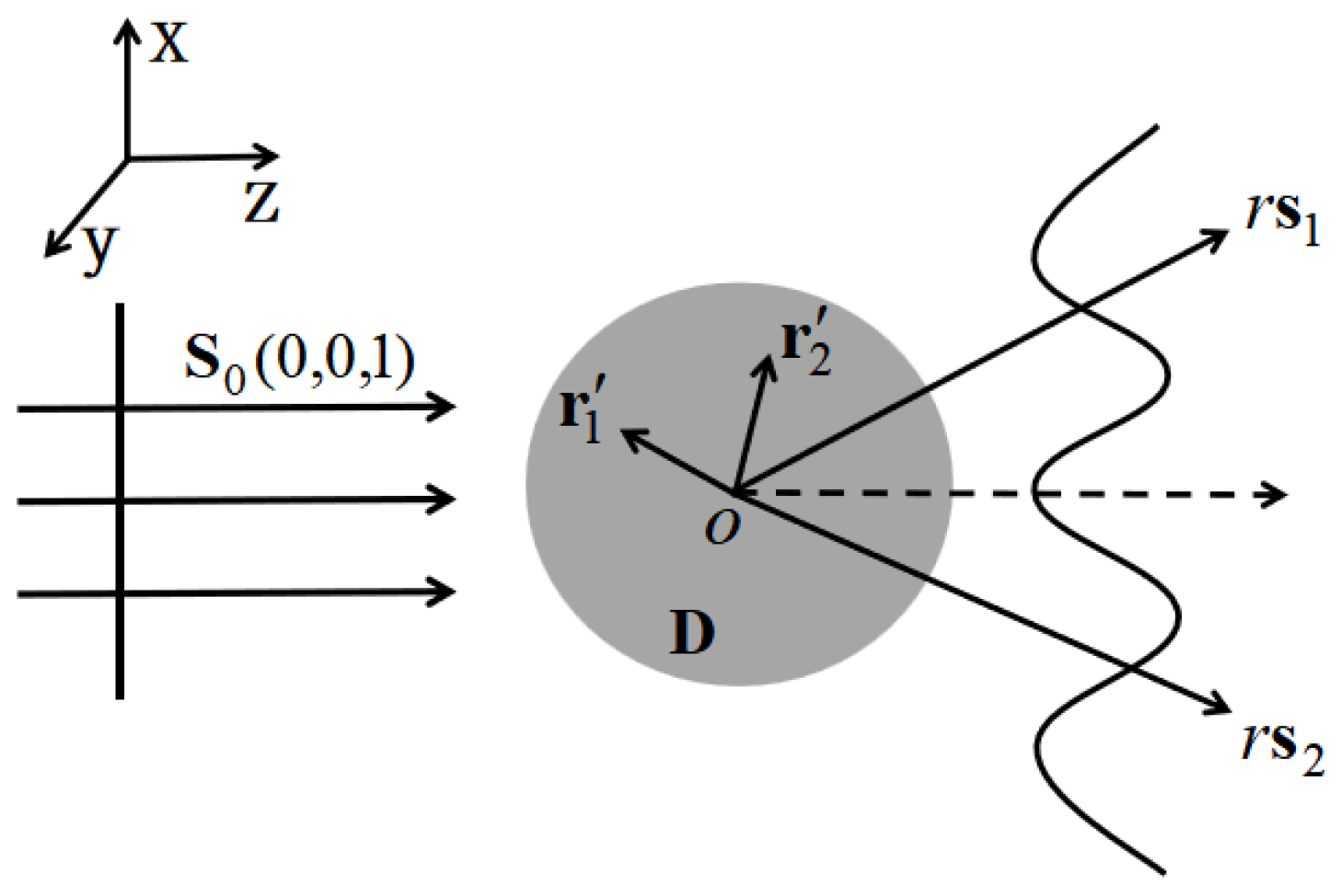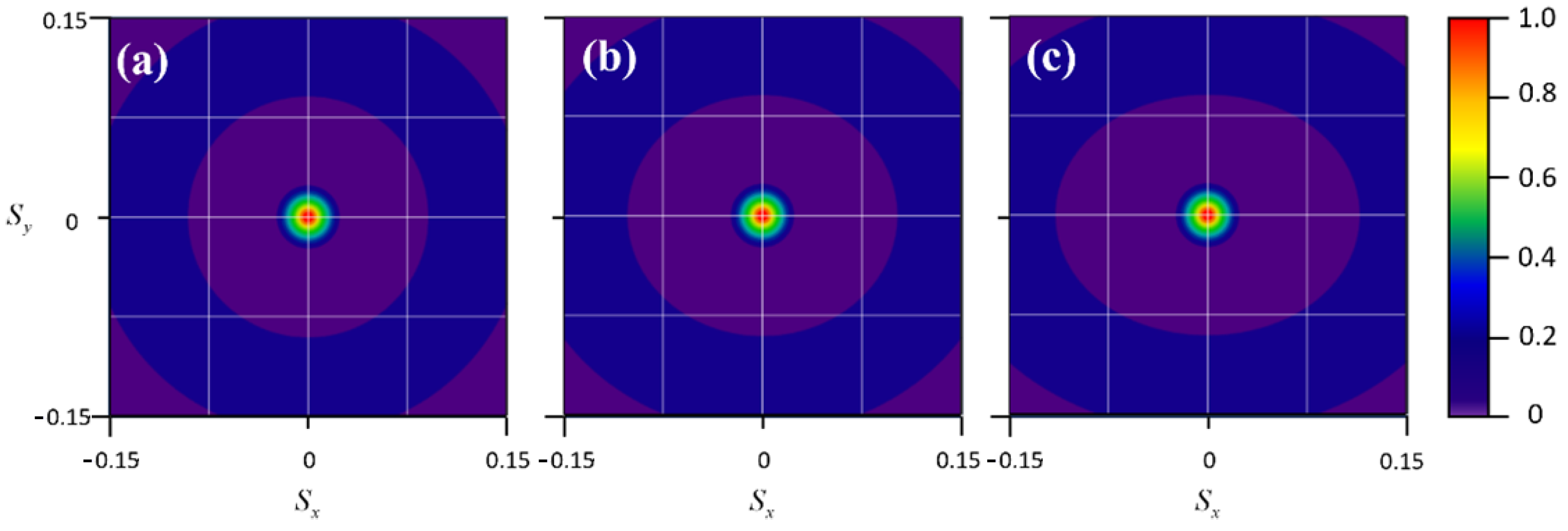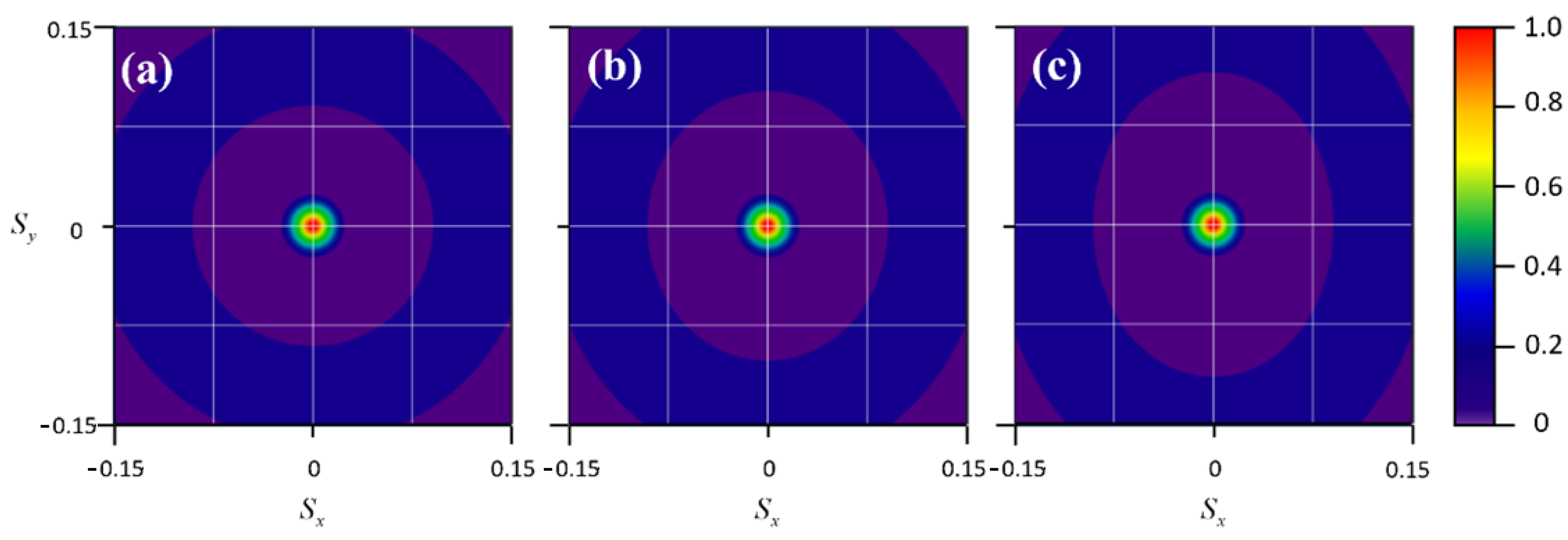Far-Zone Spectral Density of Light Waves Scattered by Random Anisotropic Hollow Medium
Abstract
1. Introduction
2. Theoretical Foundations
3. Numerical Results and Discussion
4. Conclusions
Funding
Data Availability Statement
Conflicts of Interest
References
- Asakura, T.; Shirai, T. Spectral Changes of Light and Scattering Phenomena. Opt. Rev. 1996, 1, 1–10. [Google Scholar]
- Zhao, D.; Wang, T. Direct and inverse problem in the theory of light scattering. Prog. Opt. 2012, 57, 262–308. [Google Scholar]
- Lahiri, M.; Wolf, E. Spectral changes of stochastic beams scattered on a deterministic medium. Opt. Lett. 2012, 37, 2517–2519. [Google Scholar] [CrossRef]
- Visser, T.D.; Fischer, D.G.; Wolf, E. Scattering of light from quasi-homogeneous sources by quasi-homogeneous media. J. Opt. Soc. Am. A 2006, 23, 1631–1638. [Google Scholar] [CrossRef]
- Xin, Y.; Chen, Y.R.; Zhao, Q.; Zhou, M.C. Beam radiated from quasi-homogeneous uniformly polarized electromagnetic source scattering on quasi-homogeneous media. Opt. Commun. 2007, 278, 247–252. [Google Scholar] [CrossRef]
- Cater, W.H.; Wolf, E. Scattering from quasi-homogeneous media. Opt. Commun. 1988, 67, 85–90. [Google Scholar] [CrossRef]
- Wolf, E.; Foley, J.T.; Gori, F. Frequency shifts of spectral lines produced by scattering from spatially random media. J. Opt. Soc. Am. A 1989, 6, 1142–1149. [Google Scholar] [CrossRef]
- Born, M.; Wolf, E. Principles of Optics; Cambridge University Press: Cambridge, UK, 1999. [Google Scholar]
- Wolf, E. Introduction to the Theory of Coherence and Polarization of Light; Cambridge University Press: Cambridge, UK, 2007. [Google Scholar]
- Du, X.; Zhao, D. Scattering of light by Gaussian-correlated quasi-homogeneous anisotropic media. Opt. Lett. 2010, 35, 384–386. [Google Scholar] [CrossRef]
- Du, X.; Zhao, D. Reciprocity relations for scattering from quasi-homogeneous anisotropic media. Opt. Commun. 2011, 284, 3808–3810. [Google Scholar] [CrossRef]
- Du, X.; Zhao, D. Spectral shifts produced by scattering from rotational quasi-homogeneous anisotropic media. Opt. Lett. 2011, 36, 4749–4751. [Google Scholar] [CrossRef]
- Du, X.; Zhao, D. Scattering of light by a system of anisotropic particles. Opt. Lett. 2010, 35, 1518. [Google Scholar] [CrossRef]
- Du, X.; Zhao, D. Frequency shifts of spectral lines induced by scattering from a rotational anisotropic particle. Opt. Commun. 2012, 285, 934–936. [Google Scholar]
- Du, X. Spectral shifts and spectral switches produced by the scattering system of two anisotropic particles in different distance. Opt. Express 2013, 21, 22610–22616. [Google Scholar] [CrossRef]
- Wang, T.; Li, X.; Ji, X.; Zhao, D. Spectral changes and spectral switches of light waves on scattering from a semisoft boundary medium. Opt. Commun. 2014, 324, 152–156. [Google Scholar] [CrossRef]
- Wang, T.; Jiang, Z.; Ji, X.; Zhao, D. Spectrum of an electromagnetic light wave on scattering from an anisotropic semisoft boundary medium. J. Opt. Soc. Am. A 2016, 33, 625–629. [Google Scholar]
- Sahin, S.; Gbur, G.; Korotkova, O. Scattering of light from particles with semisoft boundaries. Opt. Lett. 2011, 36, 3957–3959. [Google Scholar]
- Zhou, J.; Zhao, D. Spectral shifts and spectral switches produced by scattering from a random hollow scatterer with adjustable shell thickness. J. Opt. 2017, 19, 55609. [Google Scholar]
- Brandão, P.A.; Korotkova, O. Scattering theory for stationary materials with PT symmetry. Phys. Rev. A 2021, 103, 13502. [Google Scholar]
- Korotkova, O.; Brandão, P.A. Light scattering from stationary PT-symmetric collections of particles. Opt. Lett. 2021, 46, 1417–1420. [Google Scholar]
- Zhang, X.; Liu, Y.; Chen, Y.; Wang, F.; Cai, Y. Noncentrosymmetric far-zone spectral density induced by light scattering with random media having parity-time symmetry. Phys. Rev. A 2022, 105, 23510. [Google Scholar]
- Habashy, T.; Wolf, E. Reconstruction of scattering potentials from incomplete data. J. Mod. Opt. 1994, 41, 1679–1685. [Google Scholar]
- Zhao, D.; Korotkova, O.; Wolf, E. Application of correlation-induced spectral changes to inverse scattering. Opt. Lett. 2007, 32, 3483–3485. [Google Scholar] [PubMed]
- Wang, T.; Zhao, D. Determination of correlation function of scattering potentials of a random medium from the scattered spectral density. Phys. Lett. A 2011, 375, 780–783. [Google Scholar]
- Li, J.; Shi, Y. Application of third-order correlation between intensity fluctuations to determination of scattering potential of quasi-homogeneous medium. Opt. Express 2017, 25, 22191–22205. [Google Scholar]
- Khairy, K.; Foo, J.; Howard, J. Shapes of red blood cells: Comparison of 3D confocal images with the bilayer-couple model. Cell. Mol. Bioeng. 2008, 1, 173–181. [Google Scholar]
- Lahiri, M.; Wolf, E.; Fischer, D.G.; Shirai, T. Determination of correlation functions of scattering potentials of stochastic media from scattering experiments. Phys. Rev. Lett. 2009, 102, 123901. [Google Scholar]







Disclaimer/Publisher’s Note: The statements, opinions and data contained in all publications are solely those of the individual author(s) and contributor(s) and not of MDPI and/or the editor(s). MDPI and/or the editor(s) disclaim responsibility for any injury to people or property resulting from any ideas, methods, instructions or products referred to in the content. |
© 2025 by the authors. Licensee MDPI, Basel, Switzerland. This article is an open access article distributed under the terms and conditions of the Creative Commons Attribution (CC BY) license (https://creativecommons.org/licenses/by/4.0/).
Share and Cite
Yu, Y.; Zhang, Y.; Pu, J.; Chen, H.; Lin, H. Far-Zone Spectral Density of Light Waves Scattered by Random Anisotropic Hollow Medium. Photonics 2025, 12, 331. https://doi.org/10.3390/photonics12040331
Yu Y, Zhang Y, Pu J, Chen H, Lin H. Far-Zone Spectral Density of Light Waves Scattered by Random Anisotropic Hollow Medium. Photonics. 2025; 12(4):331. https://doi.org/10.3390/photonics12040331
Chicago/Turabian StyleYu, Yue, Yongtao Zhang, Jixiong Pu, Huanting Chen, and Huichuan Lin. 2025. "Far-Zone Spectral Density of Light Waves Scattered by Random Anisotropic Hollow Medium" Photonics 12, no. 4: 331. https://doi.org/10.3390/photonics12040331
APA StyleYu, Y., Zhang, Y., Pu, J., Chen, H., & Lin, H. (2025). Far-Zone Spectral Density of Light Waves Scattered by Random Anisotropic Hollow Medium. Photonics, 12(4), 331. https://doi.org/10.3390/photonics12040331





